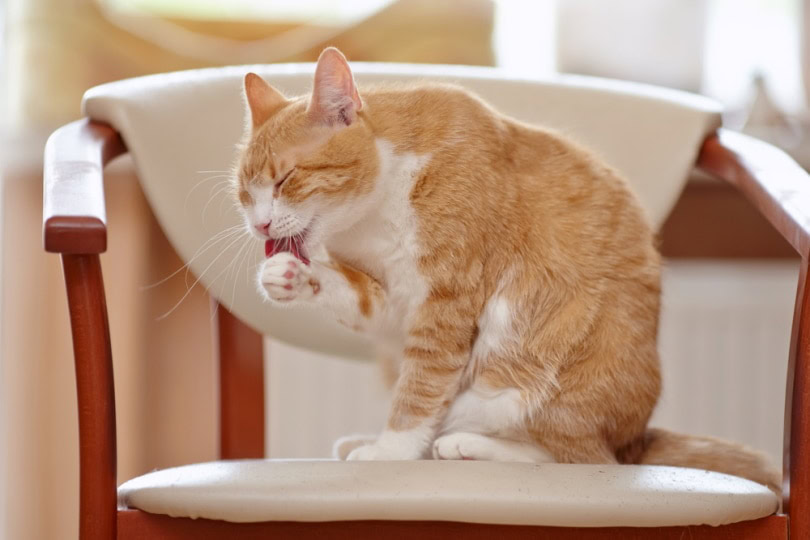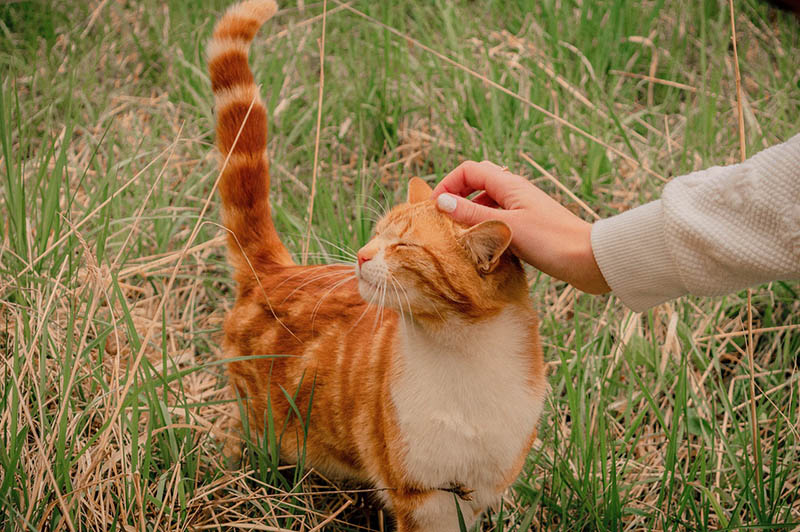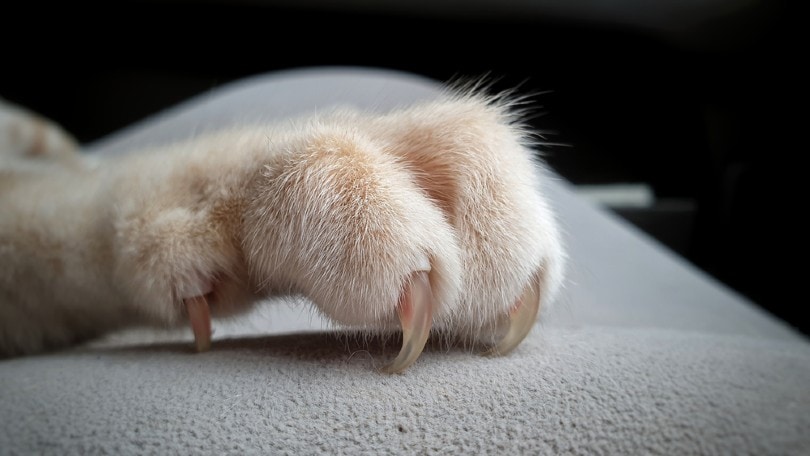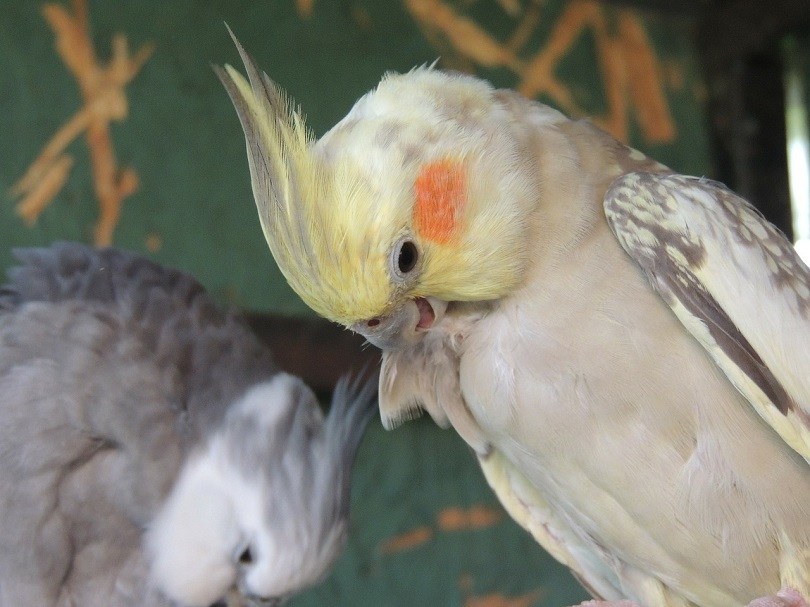VET APPROVED

The information is current and up-to-date in accordance with the latest veterinarian research.
Learn more »Click to Skip Ahead
Cats are known to be fastidious groomers, seemingly only having time to groom, eat, or sleep. They don’t often have a hair out of place, so it’s interesting to think about how much time they spend making themselves look their best.
Adult cats spend approximately 16 hours of their day asleep, so there’s only a small window of time for them to get anything else done. So how much of their time awake do they spend grooming? Cats spend, on average, around 25–30% of their time awake grooming, so as much as 2–3 hours a day1!

What Makes Cats Take Longer To Groom?
Several factors might determine how long a cat spends grooming, such as age, skin health, or the presence of external parasites, but it’s clear that all cats spend a decent chunk of their time grooming. Longhaired breeds such as Persians and Ragdolls might spend more time grooming because of the length of their hair. Long hair tends to be thicker, so it can take more time to comb it out and ensure it’s clean and tangle-free.
Cats with health problems, such as arthritis or oral issues that cause pain, will take longer to groom themselves. Arthritis is a degenerative joint condition often seen in older cats, making it hard for them to bend and lick due to pain. Painful oral conditions like periodontal disease or certain tumors can also impact the time that a cat spends grooming, and they might not be able to groom themselves at all.
If you notice your cat having trouble grooming and don’t know why, a vet visit is needed as soon as possible. Your cat can get matted and dirty easily if they cannot self-groom, and they’ll feel uncomfortable not being able to express this natural behavior.
Why Do Cats Groom Themselves So Much?
Cats groom themselves for various reasons. Cats groom to remove parasites living on their skin and in their fur, such as fleas or mites. Cats also groom to remove debris and lost hair to keep their coat free from mats and dander and to maintain the insulating capacity of the fur and temperature control. A cat will lick its entire body and use its paws to spread saliva onto its face, behind its head, and ears (which radiate a lot of heat). The saliva can act as our sweat does, cooling the body as it evaporates.
Grooming is also used to bond with other cats. While it’s not strictly self-grooming, cats will often groom others to build bonds in social groups. This is known as allogrooming, and it helps form close bonds with cats in groups such as those in feral colonies.
The most obvious reason cats groom is to keep themselves clean. However, their rough tongues can do more than remove dirt: they can brush out tangles and condition the coat by pulling natural oils down from the skin to the ends of the hair shafts.
Most pets do an excellent job of cleaning themselves, and cats are no exception. They will spend countless hours grooming, but with the Hepper Cat Brush, they no longer need to spend their days licking their loose fur.
- ONE PUSH RELEASE - This kitten brush / cat brush pops out fur with just a simple press, leaving you...
- DURABLE - Cat shedding can be a tough ordeal. Made of resilient ABS plastic and metal bristles with...
- COMFORTABLE - A cat fur brush with 60 degree angled, fine bristles and rubber stoppers will bring...
The brush is designed to be gentle yet effective, removing loose hair and stubborn knots without any painful pulling. What better way to bond with your favorite feline?
At PangoVet, we’ve admired Hepper for many years and decided to take a controlling ownership interest so that we could benefit from the outstanding designs of this cool cat company!
How Do Cats Groom Themselves?
So now we know why cats groom themselves, but how do they do it so meticulously? Cats have a few tools in their grooming arsenal! First, they have their tongues, which, if you’ve ever been lucky enough to be groomed by a cat, you know that it feels like sandpaper.
That is because a cat’s tongue is covered in barbs that face the back of their mouths, called “papillae,” which act like tiny combs. These papillae can rake through the hair shaft, removing tangles and dirt. Grooming isn’t their primary focus, however. They were designed to rake the meat from bones; it just happens that they can be used as fabulous portable brushes at the same time.
Cats also use their paws during grooming. They lick their paws and use them to spread saliva to hard-to-reach areas such as their ears, face, and back of their head. The last, more surprising grooming tool cats have is their teeth. If you’ve ever looked at your cat’s smile or looked into their mouth when they’re sleeping, you’d have noticed the tiny teeth that sit between their canines at the front. These cute little teeth are called incisors, and they’re excellent tools for use in grooming. Cats don’t use them for eating much, but they’re effective at scratching and nibbling at itches.
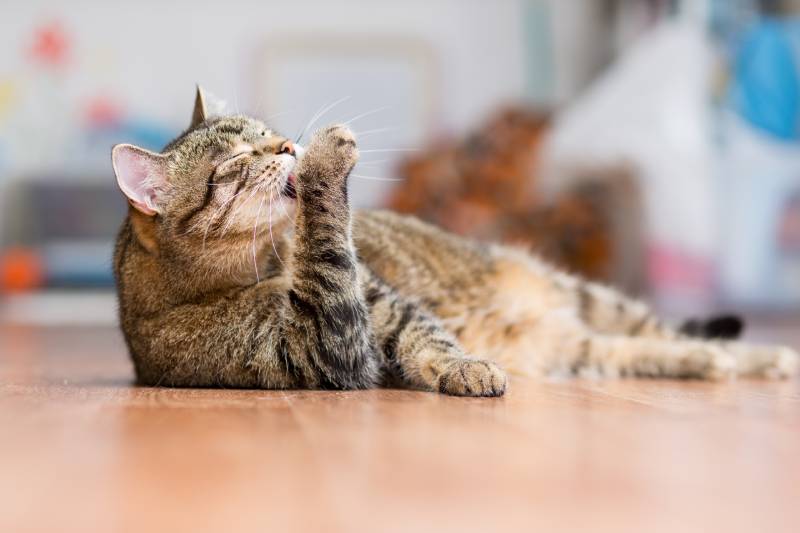
Can Cats Groom Too Much?
Unfortunately, even though cats spend hours grooming daily, they can end up grooming too much. Overgrooming occurs when regular grooming becomes obsessive and leads to harm, whether to the skin, coat, or psychologically.
There are a few reasons for overgrooming in cats, and there are some obvious (and some more subtle) signs of it occurring. Reasons for overgrooming in cats include:
- Stress: Stress is one of the most common causes of overgrooming in cats and can result from changes in the home, a conflict between cats, or stressful situations (like a trip to the vet).
- Parasite infestation: Fleas, mites, and lice can all cause a cat to overgroom. Bites from these parasites are often itchy and irritating and can cause a cat to groom over and over to try and alleviate their discomfort.
- Allergies: Following on from the last point, allergies to flea saliva are one of the most common allergies in cats. Flea allergy dermatitis is the name of this specific skin condition, which causes overgrooming and crusty lesions on the skin. Allergies to dust mites, pollens, or food, such as specific proteins, are other common allergies that can cause overgrooming.
- Pain: Cats in pain will instinctively groom an area to try to soothe it. If a cat is in chronic pain, such as with arthritis, it will overgroom to try and calm itself and relieve pa Urinary problems may also cause cats to overgroom their belly area.
- Compulsion: Some cats become obsessed with grooming and will do it to relieve anxiety. This often becomes cyclical, and the itchiness of broken hairs and sore skin from overgrooming can mean the cat grooms the area to relieve it, so the problem worsens.
- Hyperesthesia: Hyperesthesia is a condition that’s not well understood, but researchers think could be either behavioral or neurological in nature. It causes strange sensations and is characterized by rippling skin on the back and frantic overgrooming.
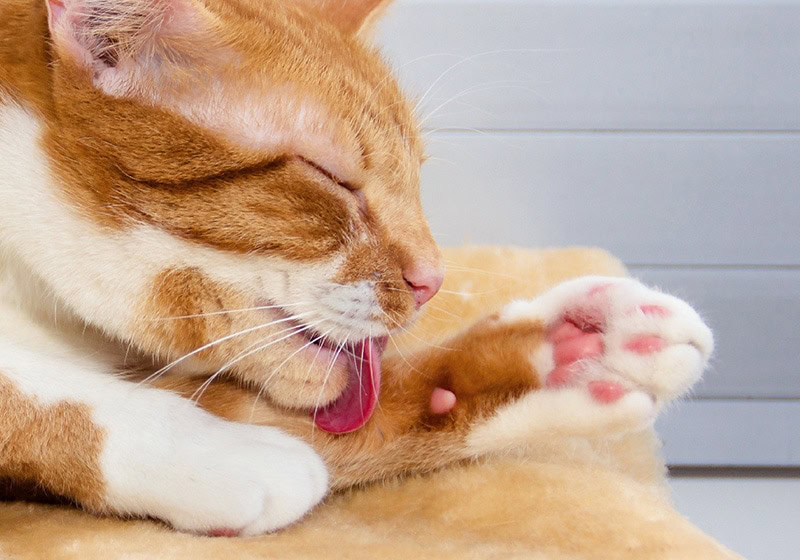
Signs of Overgrooming in Cats
Cats that overgroom can often hide the condition until the damage it causes to the skin and coat becomes extreme. Signs that a cat is overgrooming include:
- Bald patches or areas of thinning hair, which is often tufty and has broken hair shafts
- Sores, scabs, or lesions on the skin caused by the tongue and teeth
- Vomiting hairballs or fur present in the stools
- Redness of the skin (erythema)
You might also physically see your cat turning to groom almost urgently after a stressful event or situation. Keeping an eye on your cat’s normal behavior will help, as it can be tricky to distinguish between normal grooming behavior and overgrooming.
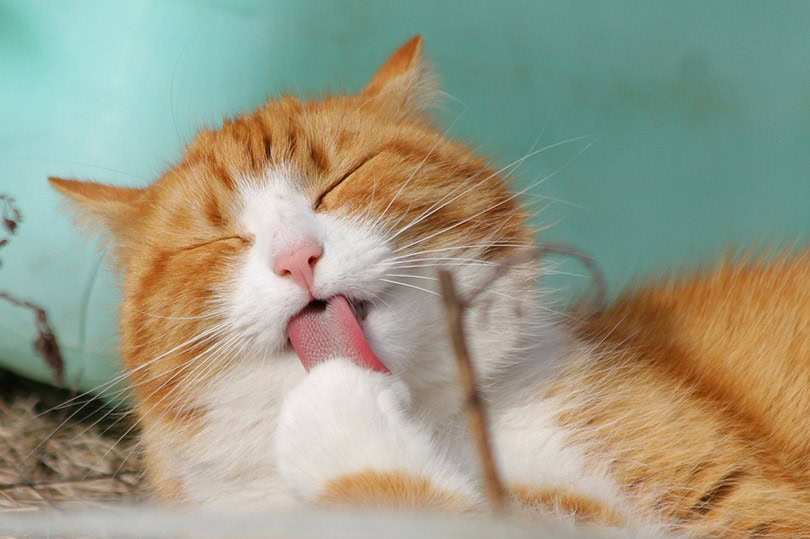
How Can I Stop My Cat from Overgrooming?
If you suspect your cat is overgrooming, the first step is to take it to the vet. Make sure to let them know when you see your cat overgrooming since it will help pinpoint what might be causing it. The vet will examine your cat and look for physical signs of overgrooming, such as broken hair shafts, thinning fur, or bald spots. They’ll identify sores on the skin and offer treatment if needed.
Your vet might prescribe several treatment options, depending on the cause of your cat’s overgrooming. If it’s a flea allergy, for example, the vet might prescribe medication to manage the itching and recommend regular flea treatment. If the problem is behavioral, they may recommend behavioral modification and stress management, including giving you advice on how to de-stress your home.

Final Thoughts
Cats are known for their meticulous grooming habits and spend a significant portion of their day cleaning themselves. The grooming needs of cats are different depending on the individual; factors such as age, health, and coat type can all affect how long they’ll spend grooming each day. Most cats will groom for almost a quarter of their waking hours, so the next time you pet your feline friend, make sure to comment on the beauty of their coat!
- https://www.vet.cornell.edu/departments-centers-and-institutes/cornell-feline-health-center/health-information/feline-health-topics/cats-lick-too-much#:~:text=Cats%20typically%20spend%20between%2030,their%20day%2C%22%20she%20says.
- https://excitedcats.com/how-many-hours-do-cats-groom/
- https://www.petmd.com/cat/general-health/how-tell-if-your-cat-over-grooming
- https://icatcare.org/advice/over-grooming/
- https://www.petmd.com/cat/general-health/how-tell-if-your-cat-over-grooming
- https://www.thedodo.com/dodowell/why-do-cats-lick-themselves
- https://iheartcats.com/cats-groom-much/
- https://catbehaviorassociates.com/why-do-cats-groom-so-much/
Featured Image Credit: Elya Vatel, Shutterstock
